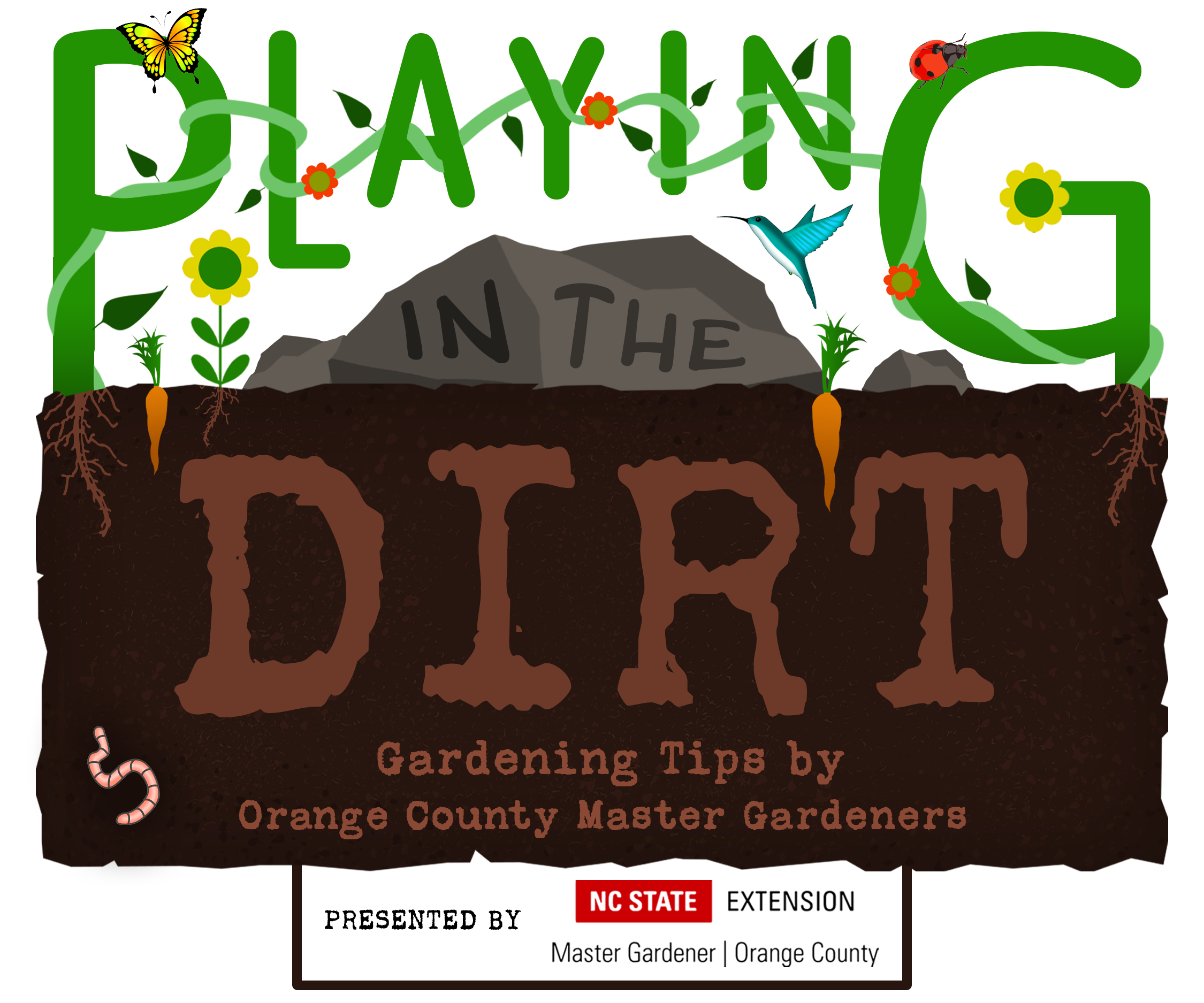
97.9 The Hill and Chapelboro.com have partnered with NC State Extension Master Gardener℠ volunteers of Orange County for “Playing in the Dirt,” a monthly column providing information and inspiration to gardeners of all skill levels! Check back on Chapelboro each month for a new subject – from our gardens to yours!
By Meg Molloy, Orange County Master Gardener℠ volunteer
Did you know that stormwater runoff is the greatest source of water pollution in urban areas? During heavy rain, water flows from rooftops, down driveways, and across parking lots and streets. As stormwater flows, it picks up many types of pollutants, including nitrates and phosphates from fertilizers, pet waste, anti-freeze, cigarette butts, motor oil, paint, household chemicals, sediment, etc. The polluted runoff then flows into streams and drinking water reservoirs.
Fortunately, there is a way that communities, developments and individual homeowners can reduce this polluted waterflow. Runoff can be managed with landscape improvements using the “rainscaping” principles of slow it down, spread it out and soak it in (the three S’s of rainscaping). The three principles can be implemented through landscape design, thoughtful plant choices and adjustments to downspouts, walkways, patios and driveways. These practices stabilize and restore eroding areas and create beautiful, natural gardens.
Slow it down:
- Create rain gardens and bioswales as garden features for managing areas where water accumulates in low spots and in ditches.
- Dig a shallow, gravel-filled trench to catch and slow runoff next to a driveway or patio or at the base of a slope.
- Install a cistern or rain barrel to capture roof runoff. Water can then be released slowly into a garden to support healthy plants.
Spread it out:
- Redirect downspout water into nearby gardens or natural areas with flexible extensions.
- Add rocks of different sizes to spread water and protect soil.
Soak it in:
- Add native plants with deep roots like native grasses, shrubs and trees to pull water deeper into the soil.
Community Partnerships Address Stormwater Runoff
Two local stormwater partnerships in Orange County brought together natural system engineering, native vegetation and community education to improve areas with stormwater challenges.
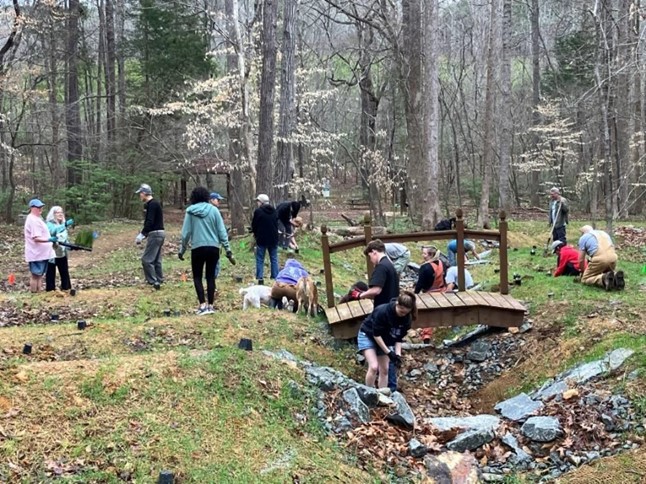
Carrboro Stormwater Collaborative community planting workday. (Photo: Cameron Binnie.)
Carrboro’s Stormwater Collaborative in Bolin Forest
The Carrboro Stormwater Collaborative recently completed a Regenerative Stormwater Conveyance (RSC) in the Bolin Forest neighborhood to prevent erosion and keep sediment and nutrients from flowing into Bolin Creek. An RSC is a natural design stormwater treatment device with a cascading series of rock structures, pools and sandy berms on a slope. Native plants and riparian seed are an important part of the RSC, as the roots use the nutrients and water and filter out pollutants before they enter the creek.
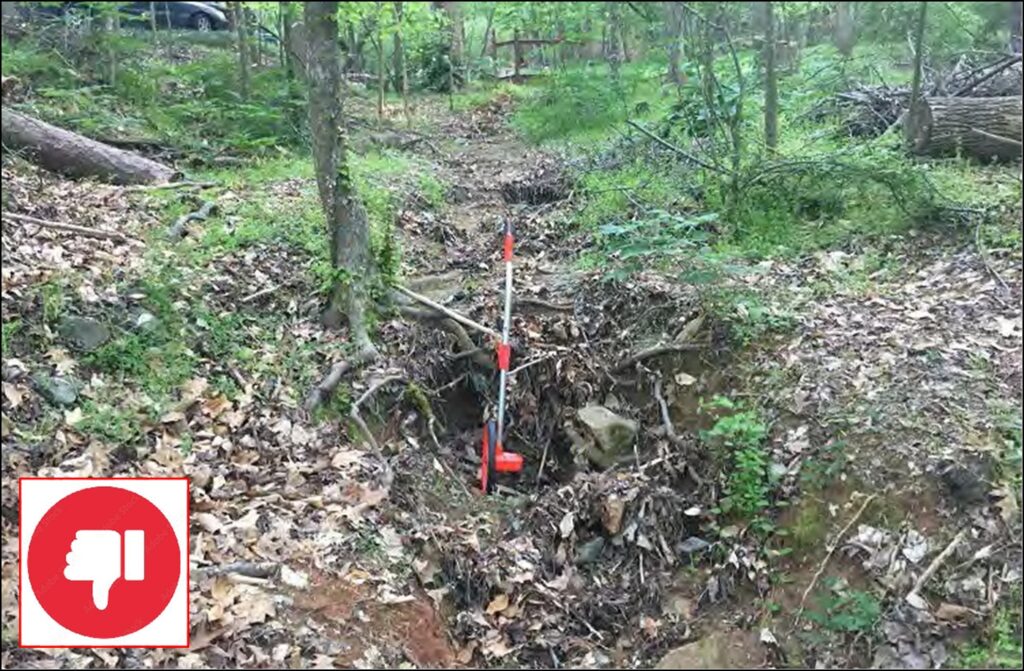
Before the Regenerative Stormwater Conveyance (RSC) was constructed in Bolin Forest. (Photo: Chris Sandt.)
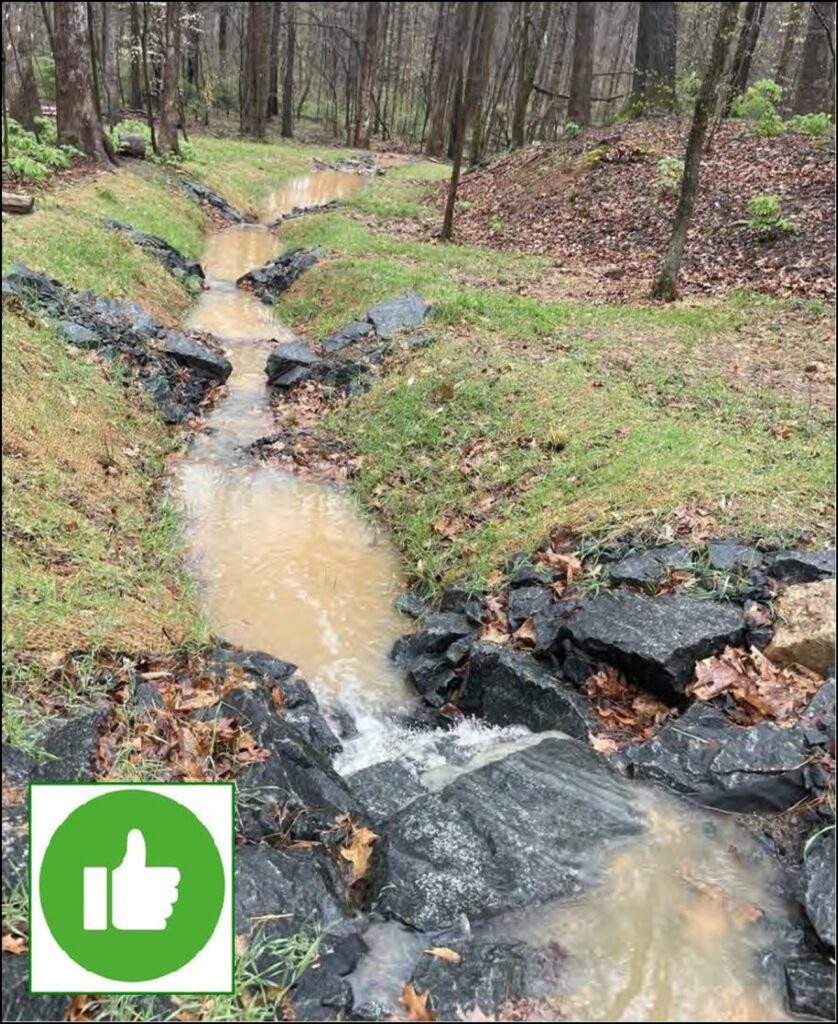
Waterflow management in Bolin Forest after completion of the RSC. (Photo: Chris Sandt.)
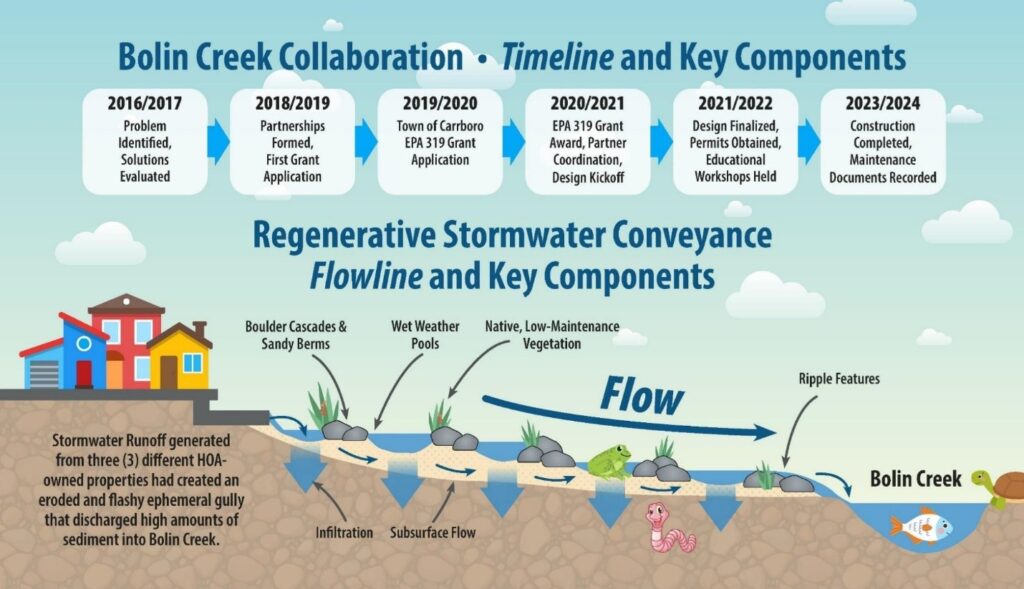
Carrboro Stormwater Collaborative Timeline. (Created by Melissa Blackburn, Graphic Designer, Orange County.)
Hillsborough’s Odie Street
The Odie Street Green Infrastructure Project in Hillsborough is a partnership with Habitat for Humanity of Orange County, the Town of Hillsborough and Piedmont Conservation Council to redevelop properties on the street and manage stormwater. Odie Street was a gravel road with significant drainage issues.
The stormwater project not only improved drainage along the street but also reduced stormwater runoff pollution by allowing stormwater to flow through newly constructed bioswales and check dams (see this factsheet). The bioswales contained a special soil mixture and were planted with either grass or native plants. The combination of plants and soil mixture work together to remove pollutants from stormwater runoff.
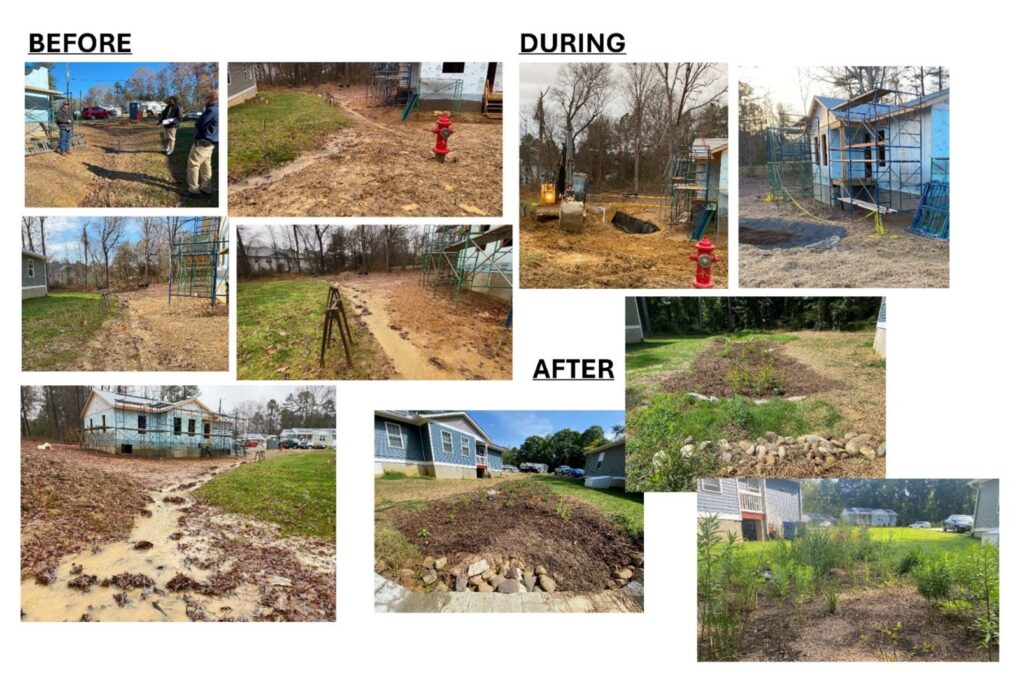
Before, during and after completion of the Odie Street stormwater project in Hillsborough. (Photos: Heather Fisher, Stormwater Program Coordinator, Town of Hillsborough.)
Home Gardeners Can Also Rainscape to Reduce Runoff
Pascale Mittendorf, professional landscape designer and Orange County Master Gardener volunteer, offers these pointers when gardening to manage water runoff:
- Nature without urbanization does a pretty good job — try to emulate natural landscape features whenever possible. When planning a new yard or renovating, always think of stormwater management as part of your landscape design. For example, installing a swale can direct water flow across an area or guide it into a rain garden.
- Be aware of impervious surfaces such as parking lots, patios, walkways and driveways that increase the speed of water flow. Surround those places with densely planted natural landscaping (see No. 5 for plant options). Install walkways and patios with a slight grade and add curb cuts in driveways so that water runs into the landscape. Use porous surfaces when possible.
- Always direct the water away from structures. Direct water away from your home by using splash blocks from gutters and use gravel or rain chains under gutterless roofs.
- Due to shallow root systems lawns do so little to reduce stormwater flow, they could be called green concrete. Replace some or all of your lawn with beds planted with a variety of native, resilient, deep-rooted plants.
- Plants that can help with stormwater management:
Carex, or sedge, is a good place to start and can be planted under other plants.
- White topped sedge can grow in very wet soil in shade or part sun.
- Pennsylvania sedge (Carex pennsylvanica) is tidy and drought resistant; it does well in part shade in an urban environment.
- Bunny Blue carex (Carex laxiculmus ‘Bunny Blue’) has a blueish tint and does well in shade.
- In shady areas, blend carex that vary in tone from light green, to green, to blue. Carex flacca ‘Blue Zinger’ is a beautiful, blue-toned sedge.
Juncus, or rushes, provide vertical structure attractive in visible areas. They can be planted in full sun and wet conditions, including the middle of a pond or stormwater pool. Steely blue juncus are beautiful, such as Blue Arrows Rush (Juncus inflexus ‘Blue Arrows’).
Native grasses with extensive root systems prevent erosion.
- Switchgrass, or panic grass (Panicum virgatum), has very deep roots and does well in part sun or part shade.
- Slender woodoats (Chasmanthium laxum) is a native grass that does well in woods, swamps, meadows and other natural areas. It grows in sun or shade, requires little maintenance and is less aggressive than Northern Sea Oats (Chasmanthium latifolium).
Native perennials that thrive in a moist, sunny environment:
- Swamp milkweed (Asclepias incarnata), cardinal flower (Lobelia) and Joe Pye weed. The small variety of Joe Pye weed is recommended — the 12-foot Joe Pye weed will overpower most gardens.
- With deer protection, a red swamp mallow (Hibiscus coccineus) is beautiful in the center of a sunny rain garden or planted at the base of a slope.
- Coreopsis, coneflowers and black-eyed Susans add color to sunny areas.
Native shrubs for streambanks, rain gardens and moist areas:
- Buttonbush (Cephalanthus occidentalis) and Virginia Sweetspire (Itea virginica) for sunny areas.
- Mountain doghobble (Leucothoe fontanesiana) for more shady areas.
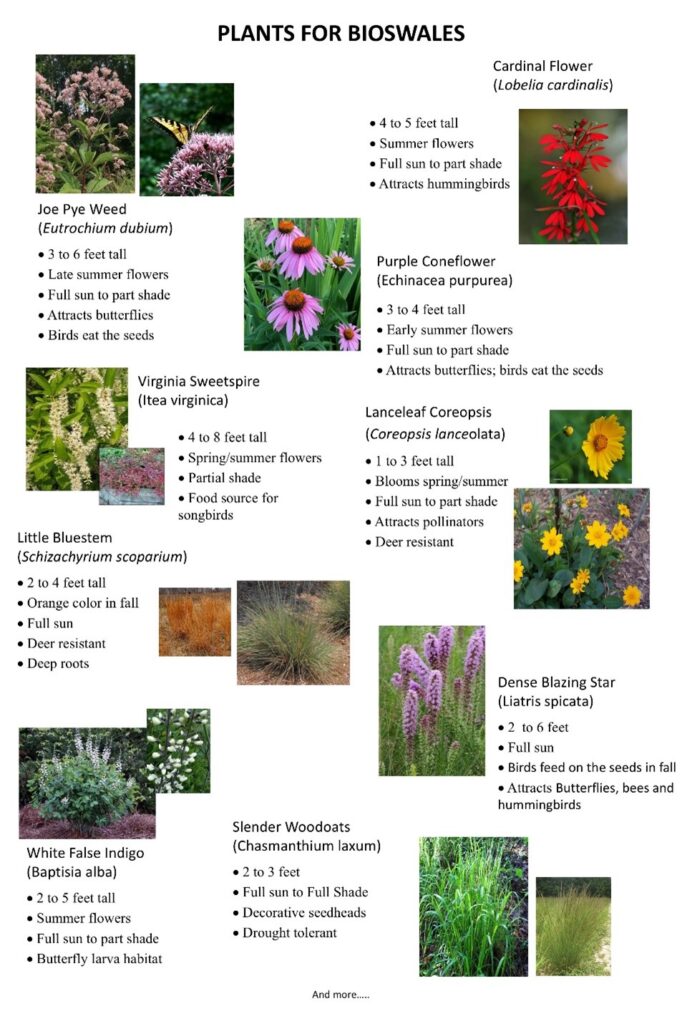
Plants for Bioswales (Poster created by Pascale Mittendorf and Heather Fisher, Stormwater Program Coordinator, Town of Hillsborough.)
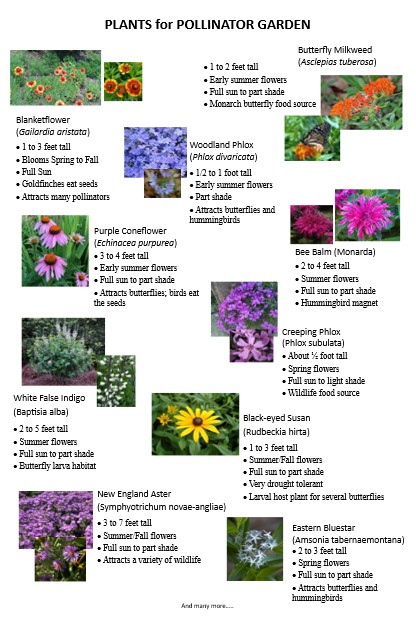
Plants for Pollinator Gardens (Poster created by Pascale Mittendorf and Heather Fisher, Stormwater Program Coordinator, Town of Hillsborough.)
More Information:
Check out these links for more information and resources on plants and stormwater management:
- Soak Up the Rain, series of resources from the Environmental Protection Agency on reducing runoff.
- Town of Carrboro Bolin Creek Stormwater Project, collaboration with neighborhoods in the Bolin Creek Watershed to reduce runoff.
- Stormwater Bioswales, Town of Hillsborough Fact Sheet.
- Rainscape, NC Water Resources Research Institute Factsheets to help you incorporate rain into your landscape.
- North Carolina Community Conservation Assistance Program (CCAP) provides educational, technical and financial assistance to landowners to install the best nonpoint source pollution (NPS) management practices on urban, suburban and rural lands.
More from the Master Gardener volunteers of Orange County:
Free gardening talks: Join the Master Gardener volunteers of Orange County for “Dig Deeper With Us,” a series of free, monthly gardening presentations. Coming up in March:
- Sunday, March 16, 2-3:30 p.m., Edible Flowers. Orange County Public Library, 137 West Margaret Lane, Hillsborough.
- Monday, March 17, 10-11:30 a.m., Edible Flowers. Seymour Center, 2551 Homestead Rd., Chapel Hill.
Join us at Farmers Markets!
- Carrboro Farmers Market – every Saturday, 9 a.m.-noon.
- Eno River Farmers Market, Hillsborough – Saturday, March 15, 10:00 a.m.-noon.
Have a plant or garden question? Email the Orange County Master Gardener Volunteers at ocmgardeners@gmail.com or phone 919-245-2061.
Follow us on Facebook! Our page is NC State Extension Master Gardener volunteers, Orange County.
Chapelboro.com does not charge subscription fees, and you can directly support our efforts in local journalism here. Want more of what you see on Chapelboro? Let us bring free local news and community information to you by signing up for our newsletter.

